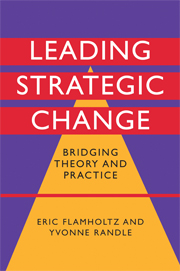Book contents
- Frontmatter
- Contents
- List of exhibits
- Preface
- Acknowledgments
- Part I An integrative framework for leading strategic and organizational change
- Part II Leading strategic change in actual organizations
- Part III Leading strategic change: lessons learned from practice
- Appendix: References for further reading on leading change
- Index
Part I - An integrative framework for leading strategic and organizational change
Published online by Cambridge University Press: 22 September 2009
- Frontmatter
- Contents
- List of exhibits
- Preface
- Acknowledgments
- Part I An integrative framework for leading strategic and organizational change
- Part II Leading strategic change in actual organizations
- Part III Leading strategic change: lessons learned from practice
- Appendix: References for further reading on leading change
- Index
Summary
There is a great deal of literature on change. Unfortunately, the literature is fragmented and requires both scholars and practitioners to create the connections.Part I of this book presents the key dimensions of a framework for leading strategic and organizational change. The proposed integrative framework is intended to be helpful as a context for understanding, planning, leading, and studying change. As shown in exhibit I.1, this framework consists of three levels and five components.
Level 1 consists of theoretical concepts/frameworks upon which a model for managing change can be built. This level has three components: (1) identifying the nature/type of change needed; (2) understanding the phases in the change process; (3) identifying ways to measure the outcome of change. In brief, the foundation of managing change is understanding the theory underlying the change management process. These three theoretical concepts are the focus of chapter 1. In this chapter we also present tools that can be used by leaders of change in applying these concepts in practice within their organizations. Taken together, the three components comprise a “theory of change” that we have found most relevant and of practical value in strategic and organizational change. Although there are other concepts and theories available, the ones presented here are the core ideas that we have actually used in our practice of change management.
Level 2 builds upon the “theory of change” and converts it to an actionable model in the form of a “strategic organizational development plan.”
- Type
- Chapter
- Information
- Leading Strategic ChangeBridging Theory and Practice, pp. 1 - 4Publisher: Cambridge University PressPrint publication year: 2008



